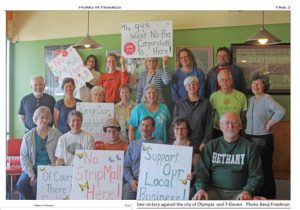A long–time WIP reader
Looking back at WIPs coverage of development in Olympia and Thurston County, the conclusion has to be that citizen opposition to many initiatives has kept planners from sacrificing neighborhoods to the demands of the market. Yet overall, development decisions continued to erode the basis for an inclusive city. Housing was and still remains out of reach for many people. Ever–renewing government plans to end homelessness are as predictable as the growth in homelessness and the claim that “bad choices”—not bad policies adopted by elected officials—are to blame.

Scanning the stories submitted to WIP offers insight into some nitty gritty details of local history. And there’s lots more than touched on here. Lots.
Stories about Olympia’s Westside tell about the community’s refusal over a 20–year period to let City planners turn the intersection of Harrison and Division into a traffic nightmare. Neighbors organized and defeated city-approved developments because the approval violated the city’s own rules. Without citizen opposition, the intersection would have had a Jack-in-the-Box drive-in on one corner and a “fuel/mini-mart” or a second convenience store on another.
In the case of the convenience store (a 7-11), WIP’s pages show how the City spent thousands of dollars defending the staff errors even up to the Superior Court where they lost a final time. Today, a community park occupies the space intended for the 7—11 – testament to the persistence of the community.
The pages of WIP also tell what’s been lost to “market forces” and what’s been saved. “On the Trail of Harmen Verbrugge and the Westside Center” shows how local businesses like Peterson’s grocery, At Home with Books, Olympic Drugs, Rainy Day Records, the Asterisk were forced out when their Canadian landlord raised rents. On the other hand, organized citizens were able to preserve open space at Grass Lake and Trillium Park.
When citizens showed that new zoning rules called the “Missing Middle” failed to comply with their own laws, the city sidestepped that finding and asked the legislature to eliminate citizen’s ability to challenge them. More recently, contributors researched city policies designed to promote higher-end apartment building downtown by exempting their owners from property tax. Read in sequence the articles chronicle 30 years of policies that are driving working people out of the city and low-income people into the street.
Stories of homelessness started with the first issues of WIP and continues to this day. Generally this “problem” was left to citizens to solve as governments did nothing or made things worse. In 1992 regular people formed Homeless Empowerment and Lodging (HELP) to offer shelter with a commitment to social integration as an alternative to the Salvation Army which denied people entry based on a list of bad behaviors.
Throughout the 90s, police regularly rousted homeless camps while businesses called for elimination of Bread and Roses, an organization that played an important role in the creation and ongoing support of other citizen efforts including Olympia’s first syringe exchange, emergency winter overnight shelters, Partners in Prevention Education, Camp Quixote, SideWalk, EGYHOP, and Food Not Bombs, among others. And then welfare reform and changes to disability rules impoverished more people.
When a key shelter at the First Baptist Church closed, the people who had been there set up camp in Sylvester Park – kicking off a 3—year successful community—led battle to convert The Fleetwood (an abandoned Pacific Telephone Central Office) into housing. A few businesspeople created “the Downtown Merchants Association” and “Friends of Sylvester Park” that failed to derail the proposal (“Homeless smear campaign targets Fleetwood”). WIP stories helped (see Pat Tassoni’s comments on next page). In 1997 the Fleetwood opened across from Sylvester Park with 43 supported apartments prioritizing veterans and other very low income people. It is still going strong. Years later, Camp Quixote, an early tiny house project (now at Mottman) was also ushered into existence by highly visible camping, assisted by churches and other activists.
In 1997, Congress repealed a law that called for replacing 1 for 1 every house lost from low income public programs – contributing to other rollbacks in funding for housing. More citizen efforts produced the “Mission of Hope Church and Sanctuary” with formerly homeless men coordinating a shelter with county-wide services. Crazy Faith offered weekly free food downtown and was warned by police that they were breaking the law by standing in a parking lot. Amahora House “Hospice without Borders” was formed to provide end of life care for the homeless. In the meantime, the County’s Crisis Clinic and Emergency Housing Network distributed a “resource guide” that said there were more shelters available in Seattle and Tacoma and suggested people could get creative: “Is camping an option?”
Into the 2000s, community members continue to be on the front lines confronting the urgency of homelessness. Two street outreach coordinators started Just Housing Olympia in 2016 to include homeless people (better described as houseless) to advocate for and meet urgent needs like a legal places to sleep and use the bathroom and as encampments grew, providing garbage removal, laundry and basic supplies. As for local jurisdictions, a table in the August 2020-WIP featured a graphic showing their 5–and 10-year plans to end homelessness, beginning in 2010 and stretching ahead seemingly forever.
Explore more coverage of these issues at www.olywip.org.
Be First to Comment